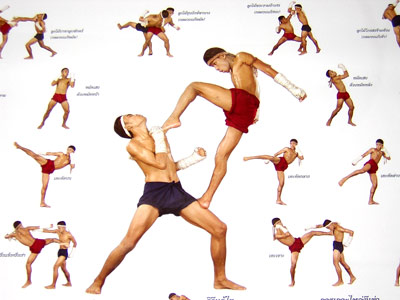
Muay Thai (Thai: มวยไทย, RTGS: Muai Thai, IPA: [mūɛj tʰāj]) is a martial art from Thailand that uses stand-up striking along with various clinching techniques. It is similar to other Indochinese styles, namely pradal serey from Cambodia, tomoi from Malaysia, lethwei from Myanmar and Muay Lao from Laos. Descended from my and muay boran, Muay Thai is Thailand’s national sport.
The word muay derives from the Sanskrit mavya and Thai comes from the word Tai. Muay Thai is referred to as the “Art of Eight Limbs” or the “Science Of Eight Limbs” because it makes use of punches, kicks, elbows and knee strikes, thus using eight “points of contact”, as opposed to “two points” (fists) in Western boxing and “four points” (hands and feet) used in sport-oriented martial arts. A practitioner of Muay Thai is known as a nak muay. Western practitioners are sometimes called nak muay farang meaning foreign boxer.
Various forms of kickboxing have long been practiced throughout mainland Southeast Asia. In Thailand, Muay Thai evolved from muay boran (ancient boxing), an unarmed combat method which would probably have been used by Siamese soldiers after losing their weapons in battle. Krabi krabong nevertheless was an important influence on Muay Boran and so Muay Thai can be seen in several kicks, holds and the movements in the wai khru which have their origins in armed combat.
Muay Boran, and therefore Muay Thai, was originally called toi muay or simply muay. As well as being a practical fighting technique for use in actual warfare, muay became a sport in which the opponents fought in front of spectators who went to watch for entertainment. These muay contests gradually became an integral part of local festivals and celebrations, especially those held at temples. It was even used as entertainment for kings. Eventually, the previously bare-fisted fighters started wearing lengths of hemp rope around their hands and forearms. This type of match was called muay khat chueak (มวยคาดเชือก).
Muay gradually became a possible means of personal advancement as the nobility increasingly esteemed skillful practitioners of the art and invited selected fighters to come to live in the royal palace to teach muay to the staff of the royal household, soldiers, princes or the king’s personal guards. This “royal muay” was called muay luang (มวยหลวง). Some time during the Ayutthaya period, a platoon of royal guards was established, whose duty was to protect king and the country. They were known as Krom Nak Muay (“Muay Kick-Fighters’ Regiment”). This royal patronage of kick-muay continued through the reigns of Rama V and VII.
Ascension of King Chulalongkorn (Rama V) to the throne in 1868 ushered in a golden age not only for muay but for the whole country of Thailand. Muay progressed greatly during the reign of Rama V as a direct result of the king’s personal interest in the art. The country was at peace and muay functioned as a means of physical exercise, self-defense, recreation, and personal advancement.Masters of the art began teaching muay in training camps where students were provided with food and shelter. Trainees would be treated as one family and it was customary for students to adopt the camp’s name as their own surname. Scouts would be sent by the royal family to organise matches between different camps. King Rama the VII pushed for codified rules for Muay Thai, and they were put into place. Thailand’s first boxing ring was built in 1921 at Suan Kularp. Referees were introduced and rounds were now timed by kick. Fighters at the Lumpinee Kickboxing Stadium began wearing modern gloves during training and in boxing matches against foreigners. Rope-binding was still used in fights between Thais but after the occurrence of a death in the ring, it was decided that fighters should wear gloves and cotton coverlets over the feet and ankles. It was also around this time that the term Muay Thai became commonly used while the older form of the style was referred to as muay boran. With the success of Muay Thai in the mixed martial arts, it has become the de facto style of choice for competitive stand-up fighters. As a result, western practitioners have incorporated much more powerful hand striking techniques from boxing although some Thai purists accuse them of diluting the art.
Training Guide to train Muay Thai in Thailand
Discuss Muay Thai
Muay Thai Websites
Incoming search terms:
- muay thai
- muay boran
- Muay Thai Boran
- thai
- muay thai kicks
- Muay Boran Techniques
- muay thai kick
- moitai
- muai tai
- thailand muay thai

1 responses to Muay Thai
Thank you for the history lesson on Muay Thai. It’s interesting that there was little known about this devastating fighting art in the United States until the UFC popularized it.
Leave a reply to Muay Thai